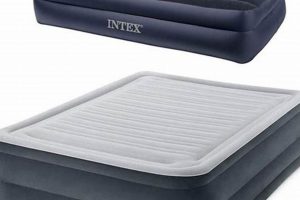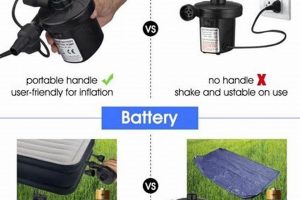The process of removing air from an inflatable sleeping surface is essential for storage and portability. This task involves creating an escape route for the pressurized air contained within the mattress, allowing it to collapse and become more manageable.
Proper air removal minimizes storage space requirements, extends the lifespan of the mattress by preventing undue stress on seams and materials, and facilitates convenient transportation. Understanding efficient techniques contributes to a more organized and mobile lifestyle.
Several approaches exist to accomplish this, ranging from utilizing integrated pumps to employing manual methods. The subsequent sections will outline these techniques, detailing the steps for effectively and efficiently reducing the volume of an inflatable mattress.
Deflating an Inflatable Mattress
Effective deflation ensures complete air removal and prevents damage to the mattress. Adherence to these tips optimizes storage and prolongs the product’s lifespan.
Tip 1: Locate the Primary Valve. Identify the designated valve for air release. This is typically larger than the inflation valve and may have a release mechanism.
Tip 2: Use Integrated Pumps Efficiently. If the mattress features an internal pump, select the deflate setting. Allow the pump to operate until the mattress is mostly deflated; manual assistance may be necessary for complete air removal.
Tip 3: Employ External Pumps for Faster Deflation. External air pumps, particularly those with vacuum capabilities, can expedite deflation. Connect the pump securely to the valve to ensure efficient suction.
Tip 4: Manually Encourage Airflow. Once the initial air volume is removed, apply pressure to the mattress surface. Kneeling or pressing firmly helps force out remaining air pockets.
Tip 5: Ensure a Complete Seal During Re-Closure. After deflation, promptly and securely close the valve. This prevents air from re-entering and maintains the reduced volume for storage.
Tip 6: Inspect for Obstructions. Before closing the valve, verify that no debris or obstructions prevent a complete seal. Foreign particles can compromise the mattress’s ability to remain deflated.
Tip 7: Fold Strategically. Begin folding the mattress from the end opposite the valve, directing remaining air towards the opening as it is rolled or folded. This further assists in complete deflation.
Tip 8: Store Appropriately. Once completely deflated and sealed, store the mattress in a cool, dry place away from sharp objects or extreme temperatures to prevent damage.
By following these guidelines, one can optimize the deflation process, ensuring convenient storage and preserving the integrity of the inflatable mattress.
The subsequent section will address potential issues that may arise during deflation and offer troubleshooting solutions.
1. Valve Location
The location and design of the valve directly impact the efficiency and ease with which an inflatable mattress can be deflated. The valve serves as the primary access point for air removal, and its characteristics determine the optimal deflation method.
- Valve Accessibility
A readily accessible valve streamlines the deflation process. Obstructed or recessed valves necessitate additional manipulation, potentially prolonging the procedure or increasing the risk of damage to the mattress material.
- Valve Type and Compatibility
Different valve types, such as standard one-way valves, wide-mouth valves, or valves integrated with electric pumps, require specific deflation techniques. Compatibility with external pumps or deflation tools is crucial for efficient air extraction.
- Valve Seal Integrity
The valve’s ability to create a tight seal is essential for maintaining deflation. A damaged or poorly designed valve may allow air to slowly leak back into the mattress, negating the deflation effort and complicating storage.
- Valve Material and Durability
The durability of the valve material influences its resistance to wear and tear during repeated deflation cycles. A robust valve can withstand the pressure and friction associated with air removal, ensuring a longer lifespan for both the valve and the mattress.
The effectiveness of any deflation technique is inherently tied to the characteristics of the valve. Understanding the valve’s design and location enables the selection of the most appropriate method for achieving complete and sustained deflation, ultimately facilitating efficient storage and transport of the inflatable mattress.
2. Pump Utilization
Pump utilization is intrinsically linked to effectively reducing the volume of an inflatable mattress. The method employed in extracting air, whether integrated or external, directly impacts the speed and thoroughness of deflation. Failure to utilize the correct pump or method negates the desired outcome, thus rendering the process incomplete.
For instance, mattresses featuring integrated electric pumps often offer a designated deflation setting. Engaging this setting initiates a mechanized extraction of air, accelerating deflation compared to solely relying on gravity or manual pressure. External pumps, particularly those designed with vacuum capabilities, provide an even more potent means of deflation. These devices actively draw air out of the mattress, ensuring a more complete reduction in volume. A common scenario involves camping mattresses where a portable electric pump is essential for expedient deflation prior to packing. In the absence of either integrated or external pumps, manual methods, such as pressing on the mattress, become necessary. These approaches, however, are often less effective and require significantly more effort.
In conclusion, pump utilization, whether through integrated mechanisms or external devices, fundamentally determines the efficiency of reducing the volume of an inflatable mattress. The selection of an appropriate pump is pivotal in achieving complete air expulsion. Understanding the causal relationship between pump selection and the degree of deflation is vital for proper storage and handling.
3. Manual pressure
Manual pressure functions as a supplementary technique in the overall process of deflating an inflatable mattress. While integrated or external pumps may initiate air expulsion, the application of manual pressure becomes crucial for achieving complete deflation, particularly when residual air remains trapped within th
e mattress’s internal chambers. Manual pressure involves applying physical force to the mattress surface, encouraging the displacement of air towards the valve.
The effectiveness of manual pressure is contingent upon the mattress’s design and the amount of air initially removed. For example, mattresses with complex internal baffling systems often require focused pressure application to force air through the intricate pathways. Furthermore, the material composition of the mattress affects the efficiency of manual pressure. More rigid materials may necessitate greater force, while flexible materials respond more readily. Improper application of manual pressure, such as concentrating force on a single point, can risk seam damage. Therefore, distributing pressure evenly across the surface is vital to prevent localized stress and potential rupture. One may consider a controlled action using their body or rigid, flat object to avoid puncturing it.
In summation, manual pressure serves as an essential component within deflation procedures, particularly when integrated or external pumps cannot achieve total air removal. Efficient utilization demands uniform pressure distribution to circumvent material damage. Understanding the interaction between mattress construction and the force applied via manual methods enhances the potential of complete deflation which enables compact storage.
4. Folding technique
The folding technique is intrinsically linked to the thoroughness and ease of deflating an inflatable mattress. Its execution significantly influences the amount of residual air remaining within the mattress and, consequently, its final packed size. A properly executed folding method actively facilitates air expulsion, while a haphazard approach can trap air pockets, hindering complete deflation. Folding from the end opposite the valve, for instance, promotes a systematic displacement of air towards the opening as the mattress is compressed. Rolling, rather than simply folding flat, often creates a more effective pressure gradient, compelling air to exit more efficiently.
Consider the scenario where an inflatable mattress is folded in a random manner without regard to the valve’s location. Pockets of air become isolated within the folds, resisting expulsion even with significant external pressure. Conversely, initiating the fold from the furthest point from the valve, combined with a rolling motion, directs the air stream towards the valve opening. This technique, when coupled with manual pressure, minimizes air entrapment and yields a significantly more compact final form, which in turn, eases both storage and transportation. A typical application involves camping, where limited packing space necessitates maximal deflation and strategic folding for efficient gear management.
In summary, the folding technique constitutes an integral component of effective inflatable mattress deflation. Its conscious application enhances the expulsion of residual air, contributing to a more compact and manageable end product. Employing a deliberate approach to folding, one which leverages air displacement principles, directly impacts storage efficiency and the overall usability of the inflatable mattress. The challenges associated with incomplete deflation and the benefits of strategic folding underscore the practical significance of understanding this connection.
5. Storage environment
The storage environment exerts a significant influence on the long-term condition and usability of an inflatable mattress, an effect directly related to the thoroughness of its deflation. Inadequate deflation prior to storage creates conditions that exacerbate the potential for material degradation. Elevated temperatures within a confined storage space, for instance, can cause any remaining air to expand, placing undue stress on the mattress seams and valve. This sustained pressure can lead to structural weakness and eventual failure. Conversely, exposure to extreme cold can compromise the elasticity of the mattress material, rendering it brittle and prone to cracking, especially when improperly folded due to insufficient deflation. The presence of moisture within the storage environment compounds these risks, fostering the growth of mold and mildew, which can damage the mattress fabric and create unsanitary conditions. A mattress stored in a damp basement, for example, is susceptible to such microbial growth, particularly if it was not completely dry upon storage.
Addressing the storage environment necessitates a multifaceted approach that complements proper deflation techniques. First, selecting a storage location characterized by stable temperature and humidity levels is paramount. Garages or attics that experience extreme temperature fluctuations are generally unsuitable. Second, ensuring the mattress is completely dry before storage minimizes the risk of mold and mildew. Air-drying the mattress after use, even if it appears clean, is a prudent measure. Third, protective storage containers or bags shield the deflated mattress from dust, pests, and physical damage. A well-sealed container also mitigates the impact of ambient environmental conditions. Practical applications of these principles extend to various contexts, from seasonal storage of guest mattresses to long-term preservation of camping equipment.
In conclusion, the storage environment and deflation are interconnected elements in prolonging the lifespan of an inflatable mattress. Thorough deflation, coupled with careful consideration of temperature, humidity, and physical protection within the storage space, optimizes preservation and minimizes the potential for material degradation. Overlooking this connection can result in premature wear, compromised hygiene, and reduced functionality, negating the initial investment in the inflatable mattress. A comprehensive approach ensures continued utility and value over time.
6. Seal integrity
Seal integrity constitutes a critical factor in the effective deflation and subsequent storage of an inflatable mattress. The valve’s capacity to form an airtight closure after air expulsion dictates the degree to which the mattress maintains its deflated state. A compromised seal undermines the deflation process, leading to gradual re-inflation and increased storage volume.
- Valve Material and Design
The material composition and design of the valve directly impact its ability to create a reliable seal. Valves constructed from pliable, durable materials are less prone to degradation and deformation, ensuring a tighter closure. Intricate valve designs, such as those incorporating multiple sealing surfaces or locking mechanisms, offer enhanced protection against air leakage. For example, a valve with a simple rubber stopper may be susceptible to degradation over time, leading to a compromised seal, whereas a valve with a threaded cap and internal O-ring offers a more robust barrier against air escape.
- Contamination and Obstruction
The presence of debris, dirt, or other foreign materials within the valve can impede proper sealing. These contaminants can create gaps between the sealing surfaces, allowing air to seep through even when the valve is ostensibly closed. Regular inspection and cleaning
of the valve area are essential for maintaining seal integrity. A common scenario involves sand or grit accumulating within the valve during outdoor use, necessitating thorough cleaning before storage. - Valve Wear and Tear
Repeated inflation and deflation cycles can gradually degrade the valve’s sealing components. The constant pressure and friction associated with these processes can lead to wear and tear, reducing the valve’s ability to form a tight seal. Regular maintenance, including lubrication or replacement of worn components, is necessary to prolong the valve’s lifespan and preserve its sealing capabilities. For example, over-tightening the valve cap can eventually damage the threads, compromising its ability to create a secure closure.
- Environmental Factors
Exposure to extreme temperatures, ultraviolet radiation, or harsh chemicals can negatively impact the valve’s material properties, leading to seal degradation. These environmental factors can cause the valve to become brittle, cracked, or deformed, impairing its ability to form an airtight closure. Storing the inflatable mattress in a cool, dry environment away from direct sunlight and corrosive substances can help mitigate these risks. For instance, prolonged exposure to direct sunlight can cause the plastic components of the valve to become brittle and prone to cracking.
The interplay between valve material, contamination, wear, and environmental factors dictates the overall integrity of the seal. Understanding these influences is crucial for optimizing deflation practices and preserving the functionality of inflatable mattresses. A well-maintained valve, free from debris and protected from environmental stressors, ensures sustained deflation and compact storage, maximizing the lifespan and usability of the product.
Frequently Asked Questions
The following section addresses common inquiries regarding the proper procedures and potential challenges associated with deflating inflatable mattresses.
Question 1: What constitutes the most efficient method for removing air from an inflatable mattress?
The optimal approach involves utilizing an integrated or external pump designed for deflation. If a pump is unavailable, manual pressure, applied systematically from the end opposite the valve, can be employed to expel remaining air.
Question 2: How can potential damage to the mattress material be avoided during deflation?
Distribute pressure evenly across the mattress surface, avoiding concentrated force on any single point. Ensure that the area is free from sharp objects that could cause punctures or tears.
Question 3: What steps should be taken if the mattress valve appears to be malfunctioning?
Inspect the valve for any visible obstructions or damage. If a blockage is present, carefully remove it. If the valve is damaged, consult the manufacturer’s warranty or seek professional repair.
Question 4: How does the external temperature affect the deflation process?
Lower temperatures may reduce the flexibility of the mattress material, making deflation more difficult. Warmer temperatures can increase air volume, potentially requiring additional effort to fully deflate the mattress.
Question 5: Is it necessary to completely remove all air from the mattress before storage?
Complete air removal is crucial for minimizing storage space and preventing undue stress on the mattress seams. Residual air can expand or contract with temperature changes, potentially leading to material damage.
Question 6: What preventative measures should be taken to ensure long-term valve integrity?
Keep the valve clean and free from debris. Avoid over-tightening the valve cap, which can damage the threads. Store the mattress in a cool, dry environment away from direct sunlight and harsh chemicals.
Proper deflation techniques extend the lifespan of an inflatable mattress and enhance its portability. Adherence to these guidelines ensures optimal performance and storage efficiency.
The subsequent section explores the implications of complete vs. incomplete deflation on the final stages of storage and potential reuse.
Deflating an Inflatable Mattress
The preceding exploration has detailed the various facets of achieving optimal deflation of inflatable mattresses. How to deflate an air mattress effectively hinges upon a multi-pronged approach, encompassing valve identification and maintenance, strategic pump utilization, controlled application of manual pressure, deliberate folding techniques, and mindful consideration of the storage environment. The interplay of these elements dictates the degree of deflation achieved and, consequently, the long-term viability of the mattress.
Ultimately, the commitment to thorough deflation reflects a commitment to responsible resource management and product stewardship. Consistent application of these principles ensures not only efficient storage and ease of transport but also prolongs the lifespan of the mattress, maximizing its utility and minimizing the environmental impact associated with premature replacement. Prioritizing proper deflation constitutes an investment in both convenience and sustainability.







